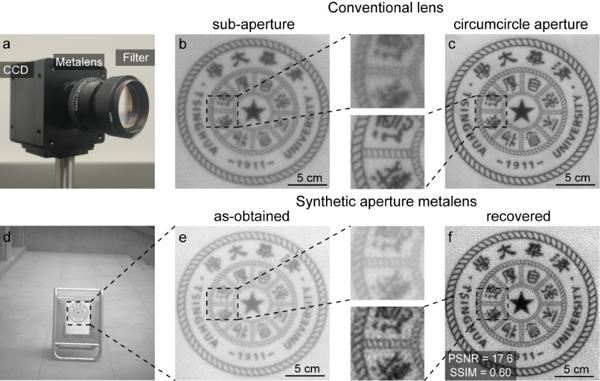Metalens is an ultrathin optical element that can focus light using densely arranged subwavelength structures. Due to its extremely small form factor, it has been considered promising for imaging applications that desire an extreme system size, weight, and power, such as in consumer electronics and remote sensing. However, as a major impediment prohibiting the wide adoption of the metalens technology, the aperture size, and consequently the imaging resolution, of a metalens is often limited by lithography processes that are not scalable.
A synthetic aperture can mix signals from a collection of sub-apertures to render an image having a resolution comparable to an aperture the size of the circumcircle of all sub-apertures. It is a technology that has been widely used in the radiofrequency regime. As a landmark example, the Event Horizon Telescope project captured and retrieved the first image of the black hole M87 through aperture synthesis of a global network of radio telescopes. Over the last decades, the synthetic aperture approach has also been adopted in the optical domain for applications ranging from remote sensing to microscopy.
In this work, a team led by Prof. Yuanmu Yang at Tsinghua University and Prof. Xiangning Chen at Space Engineering University propose to adopt a synthetic aperture approach to alleviate the issue. They experimentally demonstrate that, assisted by computational reconstruction, a synthetic aperture metalens composed of multiple metalenses with relatively small aperture size can achieve an imaging resolution comparable to a conventional lens with an equivalent large aperture.
They validate the concept via an outdoor imaging experiment performed with a synthetic aperture metalens-integrated near-infrared camera using natural sunlight for target illumination. Related results were published in Photonics Research Vol. 9, Issue 12, 2021 (Feng Zhao, Zicheng Shen, Decheng Wang, Bijie Xu, Xiangning Chen, Yuanmu Yang. Synthetic aperture metalens[J]. Photonics Research, 2021, 9(12): 12002388).
In this work, the authors address the aperture size limitation of optical metalens by adopting the synthetic aperture approach. They show that, by combining multiple metalenses with relatively small aperture size, the maximum cut-off frequency (MCF) of the modulation transfer function (MTF) of the synthetic aperture metalens can be improved to a level that is comparable to a lens with an equivalent large aperture.
For a conventional single-aperture metalens, the image can be obtained through the convolution of the target object and the point spread function (PSF) of the metalens. On the other hand, if we consider a synthetic aperture metalens composed of two sub-apertures, the as-obtained image may be blurry due to the additional side lobes in the PSF as well as the reduced intermediate frequency response of the system's MTF.
However, the maximum cut-off frequency (MCF) of the synthetic aperture is improved to a level comparable to an aperture the size of the circumcircle of both sub-apertures, thus the fine feature of the target object is retained in the convoluted signal. Subsequently, a sharper image can be recovered from the as-obtained image using recovery algorithms such as the Wiener filtering and Richardson-Lucy deconvolution.
The authors explore multiple metalens sub-aperture arrangements and experimentally demonstrate that, assisted by computational reconstruction, the synthetic aperture metalens composed of 3 or 4 sub-apertures can achieve an imaging resolution comparable to a conventional lens with an aperture the size doubling the size of all sub-apertures combined. They further build a metalens-integrated near-infrared camera and demonstrate the enhancement of the imaging resolution using synthetic aperture metalens in an outdoor setting using natural sunlight for target illumination (Fig. 1).

Fig. 1. Outdoor imaging experiment with the synthetic aperture metalens-integrated camera.
Natural sunlight was used to illuminate the target (a Tsinghua University logo) placed about 7 meters away from the camera. To demonstrate resolution enhancement using the synthetic aperture metalens-integrated camera, two images were first taken with a conventional lens with an aperture radius corresponding to the sub-aperture and circumcircle aperture radius of the 3-sub-aperture metalens, respectively. In comparison, the recovered image from the 3-sub-aperture metalens can resolve the fine lines of the target, with a resolving power comparable to the conventional circumcircle-aperture lens, and greatly improved in comparison with the conventional sub-aperture lens.
Using flat optical components, a plethora of novel sub-aperture arrangements that are difficult to realize by bulk lenses due to manufacturing constraints can be envisaged. By combining even more metalenses with a millimeter or centimeter size, it may provide a pathway towards constructing synthetic aperture metalens with an equivalent aperture size on a much larger scale, thus opening up new avenues for numerous exciting applications ahead.


